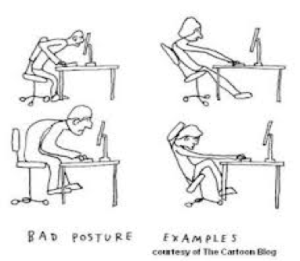Does this image look like you or your kids? Rounded shoulders, forward head and slouching? Think about all of the time that you are sitting in this position playing with your chosen electronic device (video games, ipad, smart phones, computers), watching TV, sitting at the office or at school. Today’s lifestyle for both kids and adults is an increasingly sedentary lifestyle that is creating long term effects of poor posture. Over time, poor posture can lead to serious health problems. As we all get back into our “regular” routine of more work and less vacation, it’s a good time to think about the status of your posture.
It’s all connected.
Poor posture affects your health from your head to your toes because your body is interdependent. It’s all connected. Poor posture creates a domino effect with your health. When your head is shifted off center (either forward or sideways), your body becomes imbalanced because it’s center of gravity has been shifted. For every inch of Forward Head Posture, it can increase the weight of the head on the spine by an additional 10 pounds. Imagine trying to carry a bowling ball and your head on your neck!
The rest of your body will compensate to keep itself balanced over the feet with the eyes level to the horizon. This is accomplished by the head, shoulders and hips tilting or twisting which distorts the spine. As this progression occurs, the body must compensate elsewhere to alleviate the stress/tension created from the imbalance. This improper body alignment develops unstable environments structurally and decreases the function of the nervous system.
The nervous system controls everything in your body. When there is interference to the nervous system’s function, it can cause or contribute to all kinds of symptoms and illnesses. This means that a misalignment in the spine can disrupt the body’s function leading to symptoms of pain, organ dysfunction, decreased range of motion, arthritis and just an overall loss of health. 90 percent of the brain’s energy output is used in relating the physical body to gravity. Only 10 percent has to do with thinking, metabolism, and healing. Consequently, poor posture and being out of balance will cause the brain to rob energy from thinking, metabolism, and immune function to deal with abnormal gravity/posture relationships and processing. Published research studies indicate that when body balance is restored, the body enters a healing cycle that alleviates pain and symptoms, elevates the immune system, increases blood and oxygen circulation, normalizes nervous system communication and creates more optimum body performance.
What can you do at home and at work to improve your posture and body balance?
- Be mindful of your posture
- Evaluate both work and play areas to make sure that your environment is ergonomically sound.
- Post a note or set a reminder on your phone to check your posture regularly. Chin up, shoulders back, back straight, feet on the floor. Imagine a string attached your chest and it is being pulled up from the ceiling.

- Carry less.
- Buying an extra set of books to keep at home.
- Use remote login systems to work from home and avoid carrying your laptop back and forth.
- Pack the heavier stuff closer to your body.
- Raise the back pack on the back with the adjustable straps to keep the weight closer to your body.
- Consider using a rolling backpack or briefcase.
- Take frequent breaks.
- Taking a break doesn’t mean not working or studying. If you are on the phone or studying spelling words, stand up. Moving around and changing positions doesn’t need to mean a decrease in productivity.
- Limit game playing, personal computer work and tablet time to 30-60 minutes. If you are going to spend more time, take a break every 30-60 minutes and do something else for a few minutes.
- Stretch and Strengthen.
- Stretches such as shoulder rolls or neck stretches can be incorporated into your daily routine. Stretch and strengthen both your front and back muscles for even balance.
It is important to understand that poor posture may not cause pain right away. Do not wait until the symptoms arise. Take control of the situation before it controls you.
References
Sperry, R. W. (1982) Some effects of disconnecting the cerebral hemispheres. Nobel Lecture.
Biosci. Reports 2(5), Reprinted from (221); reprinted (224)
J Manipulative Physiol Ther Nov-Dec; 18(9): 597-602 1995
Cailliet R, Gross L, Rejuvenation Strategy. New York, Doubleday and Co. 1987.
Bio:
Dr. Gray graduated Magna Cum Laude from Life Chiropractic College West. Early in her studies, Dr. Gray decided to focus as a specialist in Upper Cervical Specific Chiropractic Care. Dr. Gray completed an internship at the Institute for Advanced Care in Chiropractic. Additionally, she completed an advanced, post-doctorate training program making her a part of a select group of Chiropractors providing Upper Cervical Specific Chiropractic Care.
Dr. Gray believes that your capacity to heal is far greater than what others have led you to believe. She has a passion for serving others in the same way that she was helped through Chiropractic Care. Dr. Gray’s purpose is to help others achieve their optimum potential and the place to start is with your health. Your health affects everything you do and everyone you know. With a healthy functioning nervous system, the body is capable of self healing and self regulating and frees the individual to live to his or her optimum potential.




